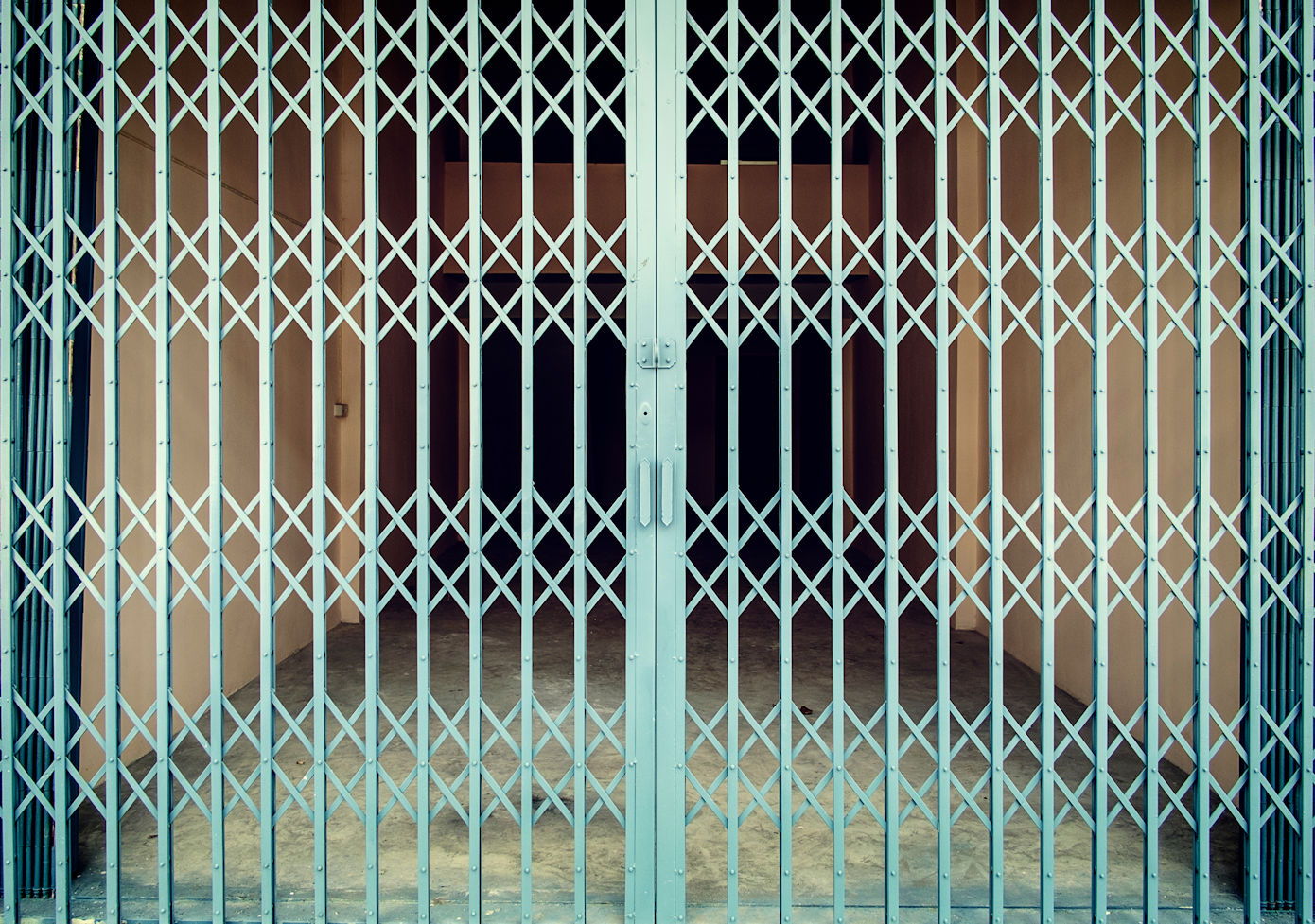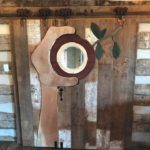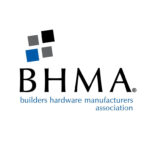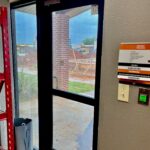Jim Elder of Secured Design LLC recently sent me a link to a discussion on Reddit, where a student posted about a change that had been made at his school. The gist of the Quick Question:
Is it code-compliant to install security grilles on multi-stall restroom entrances in schools, to prevent the use of the restrooms during times when they are not supervised?
First, although I’m not involved with Board of Education standards, I’m sure there is a requirement for students to have access to restrooms during the school day. Second, I think it’s pretty sad that kids can’t use the restroom for its intended purpose, without some of them conducting the activities that are causing schools to install security grilles.
And finally, let’s talk about egress. Security grilles – horizontal or vertical – are covered by the International Building Code (IBC) in two locations. The first is in Chapter 4, in the section addressing malls. When a horizontal sliding or vertical security grille is part of a means of egress in a mall:
- The security grille must remain fully open when the space is occupied by the general public.
- For areas served by a single exit, the security grille must not be closed when the space is occupied by 10 people or more.
- For areas served by more than one exit, the security grille must not be closed when the space is occupied by 50 people or more.
- Where the space is occupied, the grille must be openable from the egress side without special knowledge or effort.
- When two or more exits are required, security grilles may not be installed on more than one half of the exits.
The other section of the IBC addressing security grilles is in Chapter 10 – Means of Egress; in the 2021 edition of the IBC it’s Section 1010.3.4:
Security grilles. In Groups B, F, M and S, horizontal sliding or vertical security grilles are permitted at the main exit and shall be openable from the inside without the use of a key or special knowledge or effort during periods that the space is occupied. The grilles shall remain secured in the full-open position during the period of occupancy by the general public. Where two or more exits or access to exits are required, not more than one-half of the exits or exit access doorways shall be equipped with horizontal sliding or vertical security grilles.
Note that this section permits security grilles in the following occupancies: business, factory and industrial, mercantile, and storage. Security grilles are not allowed by the IBC in educational occupancies. This section states that grilles are permitted at the main exit. It’s not 100% clear whether this is referring to the building’s main exit or the main exit serving a room within the building, but the IBC Commentary includes this example referencing the building’s exits: Since the building may be partially used (e.g., team practice in a football stadium) when not fully occupied, not more than one-half of the exits from the building can be through security grilles.
In addition to the security grilles being openable from the egress side without a key or special knowledge or effort when the space is occupied, the grilles must be secured in the fully open position when the building is occupied by the general public. This section also limits security grilles to not more than half of the exits in spaces where more than one exit is required.
Based on the IBC requirements, I don’t see how a security grille on a school restroom could be code-compliant. What do you think?
You need to login or register to bookmark/favorite this content.










Apply the “”” Not everything is covered by the code rule””
1. Hopefully there is no one in the bathroom, before they use the gate.
2. If NFPA 101 was in play, I do not have the book, but appears reads like this::
Door Swing Direction
Door leaves are required to swing in the direction of egress travel only if any one of the following three conditions exist:
The door serves a room or area with an occupant load of 50 or more,
The door assembly is used in an exit enclosure,
The door opening services a high-hazard contents area.
3. So 50 or less rule, under 101, looks like gate is legal.
4. Under IBC it says 10, but only in certain places.
5. I would allow it,, bathroom use issue is school and parent problem.
Since schools often close off unused or unoccupied parts of the building, I would assume it is OK to do so.
State education codes, minimums and requirements would be the determining factor on When Do restrooms need to be available?
Your state Dept of Education will have standards, for how many toilets, etc. In my state I found this. “The entrance to toilet rooms must be able to be supervised.”
https://www.cde.ca.gov/ls/fa/sf/toiletrequire.asp.
This from the State Plumbing might be useful.
Plumbing codes and Education codes will likely have the answer. Much like Electrical codes have door hardware standards for Electrical transformer and electrical vault rooms.
In my state School plans must be reviewed by the Division of the State Architecture. Another good place to start.
Notes: State regs for schools may be your best bet:
* The California Plumbing Code does not require specific toilets for staff and students.
* LocalCalifornia Department of Education (CDE)
a. CDE recommends that the location of toilets and water fountains be distributed throughout the campus to ensure access.
b. The entrance to toilet rooms must be able to be supervised.
Thanks Glenn!
– Lori
I don’t see this as functionally much different than owners who put deadbolts on multi-user restroom doors for “cleaning” or maintenance purposes. Not all jurisdictions allow that either however, but I’ve seen it at schools, campgrounds, malls and big box stores, etc. Often there are multiple restrooms available and they only close down one set at a time.
Of course I’ve also seen security gates across school corridors many times, usually to section off just the athletic wing for example, and I always bring it to the district’s attention.
Hi Todd –
On a multi-stall restroom with a swinging door, I would use a classroom function deadbolt so that it can be unlocked from the inside using the thumbturn, but can only be locked using the key. This keeps unauthorized people from locking the door, but complies with the egress requirements. I don’t know if the security grilles on the school restrooms in question can be opened for egress from the inside, but even if they can, the person inside would need to know how to operate it.
– Lori
One cannot always find a facilities solution to people problems. I was always shy about asking to use a restroom. I have had periods of my life where considerable urgency was required. I think it is a heartless solution to but a barrier across the only restrooms accessible to the kids. What if this was being considered for the faculty restrooms?
I can understand how control is lost with a building full of young people needed to leave the classroom for this and other reasons. Seems to me that in new schools it would be expensive but workable to design rooms with one single occupant restroom accessible from the classroom.
I was always taught that the provision of unobstructed egress must be provided (excepting in places deemed approved places of detention).
In other words, generally – You can secure against access but not egress and must allow the thieves a path of escape!
Hi Ian –
Yes, that is correct. In the US model codes, there are limited locations where a door is allowed to prevent egress.
– Lori
The Code says that security grilles are allowed in “Groups B, F, M and S” occupancies. A school is, by definition, a Group E occupancy. Therefore, security grilles on a school bathroom–or in schools generally–are absolutely not allowed.
How many times have I seen a bathroom door with a deadbolt that does not comply with the egress code–either a double cylinder bolt, or worse one that cannot be opened from inside AT ALL when it is locked. Whenever I see one of those, I will contact the management and the AHJ and advise them of it, that it needs to be a classroom function deadbolt with the unlock-only inside thumbturn and they need to change it out.
And how often do schools need to have fire drills to practice how to evacuate the school in case of a fire or other emergency? One would think that anything that would be an impediment to free egress in a school wouldn’t last very long if the fire alarms are going off every month or two during fire drills. The student or staff member, upon discovering an impediment to egress during the fire drill, should report the situation and it should be corrected immediately.
And a classroom deadbolt ain’t going to cut it when the schools need to restrict access to the bathrooms while classes are in session and the kids who are skipping class need to be restricted from going into the bathroom and causing trouble, while at the same time a student who has a legitimate need for the bathroom should be able to use one. The advantage of a latchbolt over a deadbolt is so that a door can lock itself when it closes.
What I would do is to install a bathroom door and use the F09 function lockset on the door. Teachers have the hall passes on hand and students who really need to use the hall passes can borrow one from the teacher. The hall pass has a key attached. Separate hall passes should be available for the men’s and women’s restrooms, which need to be keyed differently so that men can’t go into the women’s room and women can’t go into the men’s room. With the F09 function mortise lock, the student using the bathroom takes the hall pass, opens the door with the attached key from outside, and can exit freely via the inside lever handle. But the students won’t be able to keep the door unlocked–only the staff will have the key that will lock and unlock the outside lever handle, which is controlled by the inside key cylinder. One could also add an electric strike to automatically lock and unlock the door during the class change periods. And if a student loses a hall pass key, the student’s parents should be billed for the cost of the replacement key.
While it would seem the code doesn’t permit this, it’s in the egress section. What if the grill is used to close off an isolated set of spaces as stated, thus no egress is necessary from the unoccupied area? Clearly I cannot imagine these are the only bathrooms available? Our new local HS has a large set of bathrooms in the cafeteria area, but during parts of the day there are no students in that section, staff has their own separate bathrooms. Similarly, during after school times, most of the building is open, but unoccupied rooms are locked, it may be necessary in some places to minimize remote spaces without supervision, no cameras in the bathrooms.